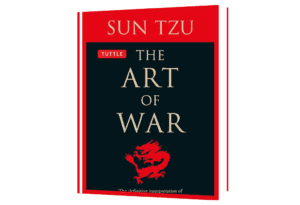“The Art of War” by Sun Tzu is a classic treatise on military strategy and tactics, composed of 13 chapters, each addressing a different aspect of warfare. This edition, interpreted by Stephen F. Kaufman, provides a definitive and accessible version of the ancient text. Here’s a summary of the key concepts covered in the book:
1. Laying Plans
– Strategic Planning: The importance of thorough planning and preparation before engaging in warfare.
– Five Factors: The Dao (Moral Law), Heaven (Weather), Earth (Terrain), the Commander, and Method and Discipline.
2. Waging War
– Economy of Warfare: The costs associated with prolonged campaigns and the importance of swift victories.
– Resource Management: Efficient use of resources to avoid unnecessary burdens on the populace.
3. Attack by Stratagem
– Strategic Superiority: The superiority of subduing the enemy without fighting.
– Deception and Intelligence: The use of intelligence and espionage to mislead and undermine the enemy.
4. Tactical Dispositions
– Defensive Strategies: The importance of positioning and defense to ensure invulnerability.
– Offensive Strategies: The balance between defense and offense in strategy.
5. Use of Energy
– Direct and Indirect Approaches: Utilizing both straightforward and unconventional methods to maintain the element of surprise.
– Efficiency in Movement: The importance of momentum and timing in military maneuvers.
6. The Army on the March
– Logistics and Terrain: The impact of different types of terrain on troop movements and logistics.
– Morale and Discipline: Maintaining high morale and strict discipline during marches and deployments.
7. Attack by Fire
–
Use of Fire: Strategies involving the use of fire to disrupt and damage the enemy.
–
Environmental Factors: Consideration of environmental conditions when using fire as a weapon.
8. Use of Spies
–
Intelligence Gathering: The crucial role of spies in gathering information and the types of spies that can be employed.
–
Strategic Deception: Using intelligence to mislead the enemy and gain a strategic edge.
Overall, “The Art of War” emphasizes the importance of strategic planning, adaptability, and intelligence in achieving victory. Kaufman’s interpretation aims to make these ancient principles accessible and relevant for contemporary readers, whether they are applied in military, business, or personal contexts
